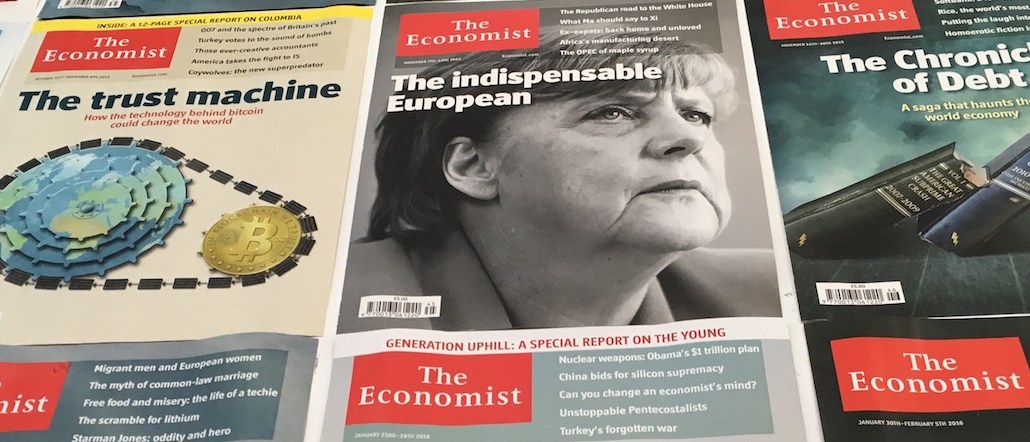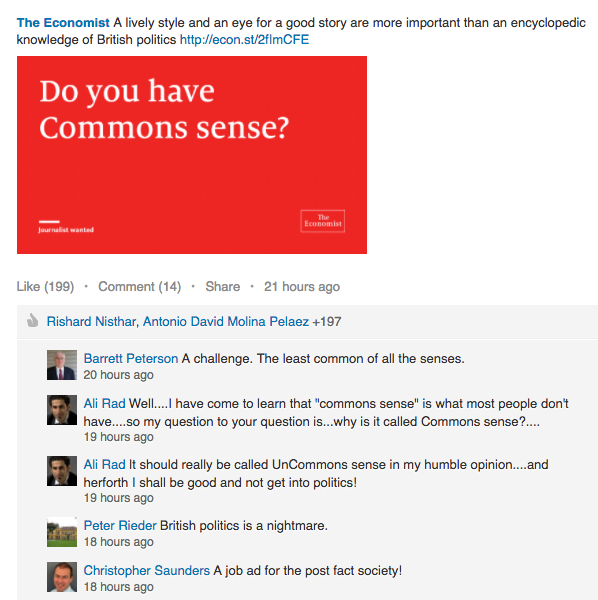Save 50% on a 3-month Digiday+ membership. Ends Dec 5.

In a platform world, publishers face tough decisions on where to place their resources. In August, The Economist faced this head on and axed its ailing Pinterest and Tumblr accounts while ramping up its commitment to LinkedIn.
The publisher had been experimenting on Pinterest for the past six months. But even with a social media team that had grown from two to 10 people, The Economist couldn’t make it click. “From day one, it was a struggle,” said Denise Law, community editor at The Economist. “We found it difficult to articulate what our raison d’être for Pinterest was. It’s not the place to share serious content; it’s more where people go to share ideas.”
For Pinterest, The Economist was posting pieces from 1843, its culture and lifestyle magazine, then called Intelligent Life. Articles from travel blog Gulliver’s Travels were also going there, as well as pieces from its archives and links to items from The Economist Store. But it was gaining no traction. When it cut the account, it had 5,000 followers. “Not enough to move the needle,” said Law, adding that its Tumblr account shared the same fate. Earlier this year, The Economist also culled a number of its Twitter accounts.
The Economist’s approach to social media is, according to the publisher, to promote quality over quantity. It’s taken that mission to LinkedIn, which it uses for brand awareness rather than to drive traffic. By tweaking its approach to publish a broader spectrum of content, The Economist saw its LinkedIn follower count grow from half a million last year to 2.4 million, and it continues to grow at a rate of 25,000 followers a week, according to Law.
When it first started actively posting to LinkedIn in September 2015, the team focused on posting only business and finance content in line with assumptions about its readers on the platform. By June 2016, the growth rate started to plateau. The publisher realized readers on LinkedIn, professionals who are trying to get an edge in their career, have a variety of interests.
“Limiting content on LinkedIn to business and finance also limited the followers we could attract,” wrote Edmund Henry, social media writer at The Economist. To meet these needs, it broadened the article topics to include art, culture and entertainment, areas covered in The Economist on other platforms. It started to include more articles like this about a machine that blends wine, or this on how not to annoy a flight attendant, and started posting content, audio, visual, charts and articles, on the hour throughout the day.
The growth was immediate but only continued for another month, so it made the decision to cut the amount of content it posts in half to once every two hours. Again followers picked up. It found that overly local political stories don’t fare so well on LinkedIn, something like John Kerry’s attempted deals with Russia to end the violence in Syria is too specific, while pieces with broader appeal on Brexit and the U.S. elections get more traction.
Ad position: web_incontent_pos1
It has also experimented with specific LinkedIn formats. It posts red templates with questions that link to an article. It prompts the readers to respond to the question in the comments, building up direct connections with them. Again, anything overly local, too wordy or complex tends not to fly, but so far readers are engaged. Questions like “Should company boards have gender quotas?” or “Do you have common sense?” have had hundreds of comments, where usually posts on LinkedIn get just one or two.

More in Media

What publishers are wishing for this holiday season: End AI scraping and determine AI-powered audience value
Publishers want a fair, structured, regulated AI environment and they also want to define what the next decade of audience metrics looks like.

Digiday+ Research Subscription Index 2025: Subscription strategies from Bloomberg, The New York Times, Vox and others
Digiday’s third annual Subscription Index examines and measures publishers’ subscription strategies to identify common approaches and key tactics among Bloomberg, The New York Times, Vox and others.

From lawsuits to lobbying: How publishers are fighting AI
We may be closing out 2025, but publishers aren’t retreating from the battle of AI search — some are escalating it, and they expect the fight to stretch deep into 2026.
Ad position: web_bfu
